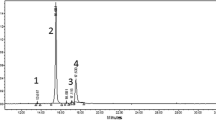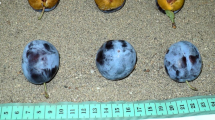Abstract
Main conclusion
Rare red currants colors caused by low anthocyanin content in the pink and a lack of anthocyanins in the white cultivar correlated with low ANS gene expression, enzyme activity, and increased sugar/acid ratios.
Changes in the contents of polyphenols, sugars, and organic acids in berries of the three differently colored Ribes rubrum L. cultivars (‘Jonkheer van Tets’, ‘Pink Champagne’, and ‘Zitavia’) were determined by LC–MS and HPLC at 4 sampling times during the last month of fruit ripening. The activities of the main flavonoid enzymes, chalcone synthase/chalcone isomerase (CHS/CHI), flavanone 3-hydroxylase (FHT), and dihydroflavonol 4-reductase (DFR), and the expression of anthocyanidin synthase (ANS) were additionally measured. Despite many attempts, activities of flavonol synthase and glycosyltransferase did not show reliable results, the reason of which they could not be demonstrated in this study. The pink fruited cultivar ‘Pink Champagne’ showed generally lower enzyme activity than the red cultivar ‘Jonkheer van Tets’. The white cultivar ‘Zitavia’ showed very low CHS/CHI activity and ANS expression and no FHT and DFR activities were detected. The DFR of R. rubrum L. clearly preferred dihydromyricetin as substrate although no 3′,4′,5′-hydroxylated anthocyanins were present. The anthocyanin content of the red cultivar slightly increased during the last three weeks of ripening and reached a maximum of 890 mg kg−1 FW. Contrary to this, the pink cultivar showed low accumulation of anthocyanins; however, in the last three weeks of ripening, their content increased from 14 to 105 mg kg−1 FW. Simultaneously, the content of polyphenols slightly decreased in all 3 cultivars, while the sugar/acid ratio increased. The white cultivar had no anthocyanins, but the sugar/acid ratios were the highest. In the white and pink cultivars, reduction/lack of anthocyanins was mainly compensated by increased relative concentrations of hydroxycinnamic acids and flavonols.


Similar content being viewed by others
Abbreviations
- ANS:
-
Anthocyanidin synthase
- CHS/CHI:
-
Chalcone synthase/chalcone isomerase
- DFR:
-
Dihydroflavonol 4-reductase
- DHK:
-
Dihydrokaempferol
- DHM:
-
Dihydromyricetin
- DHQ:
-
Dihydroquercetin
- FHT:
-
Flavanone 3-hydroxylase
- TPC:
-
Total phenolic content
References
Ben-Simhon Z, Judeinstein S, Trainin T, Harel-Beja R, Bar-Ya’akov I, Borochov-Neori H, Holland D (2015) A “white” anthocyanin-less pomegranate (Punica granatum L.) caused by an insertion in the coding region of the leucoanthocyanidin dioxygenase (LDOX;ANS) gene. PLoS One 10(11):e0142777. doi:10.1371/journal.pone.0142777
Carbone F, Preuss A, De vos RCH, D’amico E, Perrotta G, Bovy AG, Martens S, Rosati C (2009) Developmental, genetic and environmental factors affect the expression of flavonoid genes, enzymes and metabolites in strawberry fruits. Plant Cell Environ 32:1117–1131
Castellarin SD, Gaspero GD (2007) Transcriptional control of anthocyanin biosynthetic genes in extreme phenotypes for berry pigmentation of naturally occurring grapevines. BMC Plant Biol 7:46. doi:10.1186/1471-2229-7-46
Davies KM, Schwinn KE, Deroles SC, Manson DG, Lewis DH, Bloor SJ, Bradley JM (2003) Enhancing anthocyanin production by altering competition for substrate between flavonol synthase and dihydroflavonol 4-reductase. Euphytica 131:259–268
Dixon RA, Liu C, Jun JH (2013) Metabolic engineering of anthocyanins and condensed tannins in plants. Curr Opin Biotechnol 24:329–335
Fischer TC, Halbwirth H, Meisel B, Stich K, Forkmann G (2003) Molecular cloning, substrate specificity of the functionally expressed dihydroflavanol 4-reductases from Malus domestica and Pyrus comunis cultivars and the consequences for flavonoid metabolism. Arch Biochem Biophys 412:223–230
Gavrilova V, Kajdžanoska M, Gjamovski V, Stefova M (2011) Separation, characterization and quantification of phenolic compounds in blueberries and red and black currants by HPLC-DAD-ESI-MSn. J Agric Food Chem 59:4009–4018
Grimplet J, Deluc LG, Tillet RL, Wheatley MD, Schlauch KA, Cramer GR, Cushman JC (2007) Tissue-specific mRNA expression profiling in grape berry tissues. BMC Genom 187:1–23
Halbwirth H, Puhl I, Haas U, Jezik K, Treutter D, Stich K (2006) Two-phase flavonoid formation in developing strawberry (Fragaria × ananassa) fruit. J Agric Food Chem 54:1479–1485
Halbwirth H, Waldner I, Miosic S, Ibanez M, Costa G, Stich K (2009) Measuring flavonoid enzyme activities in tissues of fruit species. J Agric Food Chem 57:4983–4987
He JJ, Liu YX, Pan QH, Cui XY, Duan CQ (2010) Different anthocyanin profiles of the skin and the pulp of Yan73 (Muscat Hamburg × Alicante Bouschet) grape berries. Molecules 15:1141–1153. doi:10.3390/molecules15031141
Jaakola L (2013) New insights into the regulation of anthocyanin biosynthesis in fruits. Trends Plant Sci 18:477–483
Jaakola L, Määttä K, Pirttila AM, Törrönen R, Kärenlampi S, Hohtola A (2002) Expression of genes involved in anthocyanin biosynthesis in relation to anthocyanin, proanthocyanidin, and flavonol levels during bilberry fruit development. Plant Physiol 130:729–739
Li XG, Wang J, Yu ZY (2015) Cloning of an anthocyanidin synthase gene homolog from blackcurrant (Ribes nigrum L.) and its expression at different fruit stages. Genet Mol Res 14:2726–2734
Lugasi J, Hóvári J, Kádár G, Dénes F (2011) Phenolics in raspberry, blackberry, and currant cultivars grown in Hungary. Acta Aliment 40:52–64
Määttä K, Kamal-Eldin A, Törrönen R (2001) Phenolic compounds in berries of black, red, green, and white currants (Ribes sp.). Antioxid Redox Sign 3:981–993
Määttä KR, Kamal-Eldin A, Törrönen AR (2003) High-performance liquid chromatography (HPLC) analysis of phenolic compounds in berries with diode array and electrospray ionization mass spectrometric (MS) detection: Ribes species. J Agric Food Chem 51:6736–6744
Mattila PH, Hellström J, Karhu S, Pihlava JH, Veteläinen M (2016) High variability in flavonoid contents and composition between different North-European currant (Ribes spp.) varieties. Food Chem 204:14–20
McGuire RG (1992) Reporting of objective color measurements. HortScience 27:1254–1255
Mikulic-Petkovsek M, Rescic J, Schmitzer V, Stampar F, Slatnar A, Koron D, Veberic R (2015) Changes in fruit quality parameters of four Ribes species during ripening. Food Chem 173:363–374
Mikulic-Petkovsek M, Koron D, Veberic R (2016) Quality parameters of currant berries from three different cluster positions. Sci Hort 210:188–196
Milivojevic J, Slatnar A, Mikulic-Petkovsek M, Stampar F, Nikolic M, Veberic R (2012) The influence of early yield on the accumulation of major taste and health related compounds in black and red currant cultivars (Ribes spp.). J Agric Food Chem 60:2682–2691
Mu L, He JJ, Pan QH, He F, Duan CQ (2014) Tissue-specific accumulation of flavonoids in grape berries is related to transcriptional expression of VvF3′H and VvF3′5′H. S Afr J Enol Vitic 35(1):68–81
Pantelidis GE, Vasilakakis M, Manganaris GA, Diamantidis G (2007) Antioxidant capacity, phenol, anthocyanin and ascorbic acid contents in raspberries, blackberries, red currants, gooseberries and Cornelian cherries. Food Chem 102:777–783
Primetta AK, Karppinen K, Riihinen KR, Jaakola L (2015) Metabolic and molecular analyses of white mutant Vaccinium berries show down-regulation of MYBPA1-type R2R3 MYB regulatory factor. Planta 242:631–643. doi:10.1007/s00425-015-2363-8
Sandermann H, Strominger JL (1972) Purification and properties of C55-isoprenoid alcohol phosphokinase from Staphylococcus aureus. J Biol Chem 247:5123–5131
Shi L, Cao S, Shao J, Chen W, Zheng Y, Jiang Y, Yang Z (2014) Relationship between sucrose metabolism and anthocyanin biosynthesis during ripening in Chinese Bayberry fruit. J Agric Food Chem 62(43):10522–10528
Singleton VL, Orthofer R, Lamuela-Raventós RM (1999) Analysis of total phenols and other oxidation substrates and antioxidants by means of Folin-Ciocalteu reagent. Methods Enzymol 299:152–178
Slatnar A, Mikulic Petkovsek M, Halbwirth H, Stampar F, Stich K, Veberic R (2012) Polyphenol metabolism of developing apple skin of a scab resistant and a susceptible apple cultivar. Trees 26:109–119
Solfanelli C, Poggi A, Loreti E, Alpi A, Perata P (2006) Sucrose-specific induction of the anthocyanin biosynthetic pathway in Arabidopsis. Plant Physiol 140:637–646
Tanaka Y, Sasaki N, Ohmiya A (2008) Biosynthesis of plant pigments: anthocyanins, betalains and carotenoids. Plant J 54:733–749. doi:10.1111/j.1365-313X.2008.03447
Thill J, Miosic S, Mikulic-Petkovsek M, Slatnar A, Paltram R, Pober S, Gotame T, Veberic R, Halbwirth H, Stich H (2012a) Polyphenol metabolism in different cultivars and developmental stages of strawberry (Fragaria) fruits. Book of abstracts, 2nd Symposium on Horticulture in Europe, Angers
Thill J, Regos I, Farag MA, Ahmad AF, Kusek J, Castro A, Schlangen K, Carbonero CH, Gadjev IZ, Smith LMY, Halbwirth H, Treutter D, Stich K (2012b) Polyphenol metabolism provides a screening tool for beneficial effects of Onobrychis viciifolia (sainfoin). Phytochemistry 82:67–80
Veberic R, Slatnar A, Bizjak J, Stampar F, Mikulic-Petkovsek M (2015) Anthocyanin composition of different wild and cultivated berry species. LWT-Food Sci Technol 60:509–517
Wang H, Fan W, Li H, Yang J, Huang J, Zhang P (2013) Functional characterization of dihydroflavonol-4-reductase in anthocyanin biosynthesis of purple sweet potato underlies the direct evidence of anthocyanins function against abiotic stresses. PLoS One 8(11):e78484. doi:10.1371/journal.pone.0078484
Wei H, Chen X, Zong X, Shu H, Gao D, Liu Q (2015) Comparative transcriptome analysis of genes involved in anthocyanin biosynthesis in the red and yellow fruits of sweet cherry (Prunus avium L.). PLoS One 10(3):e0121164. doi:10.1371/journal.pone.0121164
Yang B, Zheng J, Laaksonen O, Tahvonen R, Kallio H (2013) Effects of latitude and weather conditions on composition and contents of phenolic compounds in green, red, and white currants (Ribes spp.). J Agric Food Chem 61:3517–3532
Yang Y, Yao G, Yue W, Zhang S, Wu J (2015) Transcriptome profiling reveals differential gene expression in proanthocyanidin biosynthesis associated with red/green skin color mutant of pear (Pyrus communis L.). Front. Plant Sci 6:795. doi:10.3389/fpls.2015.00795
Zhao J, Dixon RA (2010) The ‘ins’ and ‘outs’ of flavonoid transport. Trends Plant Sci 15(2):72–80. doi:10.1016/j.tplants.2009.11.006
Zhao X, Yuan Z, Feng L, Fang Y (2015) Cloning and expression of anthocyanin biosynthetic genes in red and white pomegranate. J Plant Res 128:687–696
Zheng Y, Tian L, Liu H, Pan O, Zhan J, Huang W (2009) Sugars induce anthocyanin accumulation and flavanone 3-hydroxylase expression in grape berries. Plant Growth Regul 58:251–260
Zorenc Z, Veberic R, Stampar F, Koron D, Mikulic-Petkovsek M (2016) White versus blue: does the wild ‘albino’ bilberry (Vaccinium myrtillus L.) differ in fruit quality compared to the blue one? Food Chem 211:876–882
Acknowledgements
The research is part of program Horticulture No. P4-0013-0481 funded by the Slovenian Research Agency (ARRS). Olly S. Hutabarat gratefully acknowledges Hasanuddin University (Agricultural Engineering Department, Makassar, South Sulawesi, Indonesia), the Ministry of Education and Culture of the Republic of Indonesia (DIKTI), and Austrian Agency for International Cooperation in Education and Research (OeAD-GmbH) for enabling the performance of the PhD studies abroad.
Author information
Authors and Affiliations
Corresponding author
Additional information
Special topic: Polyphenols II: biosynthesis and function in plants and ecosystems. Guest editor: Stefan Martens.
Electronic supplementary material
Below is the link to the electronic supplementary material.
Rights and permissions
About this article
Cite this article
Zorenc, Z., Veberic, R., Koron, D. et al. Polyphenol metabolism in differently colored cultivars of red currant (Ribes rubrum L.) through fruit ripening. Planta 246, 217–226 (2017). https://doi.org/10.1007/s00425-017-2670-3
Received:
Accepted:
Published:
Issue Date:
DOI: https://doi.org/10.1007/s00425-017-2670-3




